|
|
|
 |
|
| Rapier Cold Steel Cavalier Rapier Sword (88FCR) |
Points: 15
|
Cold Steel’s interpretation of this blade (which we have named the Cavalier Rapier) features a sharp double edged and needle tipped blade which is decidedly shorter and lighter than a classic Rapier, allowing for much more speed and agility. With a tempered steel pierced shell guard, rings, quillons and knuckle bow it offers astonishingly good hand protection, while its wire wrapped grip and counter balancing pommel give great comfort and liveliness in-hand. Provided complete with a hand-stitched leather sheath with steel throat, chape and integral belt hook for ease of carry
|
|
|
|
|
|
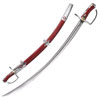 |
|
| Sword Cold Steel Polish Saber (88RPS) |
Points: 20

|
With a fully sharpened, distal tapered and strongly curved blade, the Polish Saber is capable of delivering exceptional cuts, while still remaining stiff enough for the thrust.
|
|
|
|
|
|
 |
|
| Cold Steel Hand-And-A-Half Sword Man At Arms Collection (88HNHM) |
Points: 10
|
These practical and battle ready swords lack the gleaming blades and polished silver steelwork of our other swords, but they pack a resounding punch where it counts!
Approximating the quality and performance of our high end swords, the Man at Arms collection features a selection of some of our finest high performance blades but at a markedly reduced price.
Their fully sharpened and blued blades have a distinctive gun metal finish that compliments their black leather handles, and when well-oiled they are gleamingly beautiful in their own right.
|
|
|
|
|
|
 |
|
| Maldon Seax Battlecry (404119) |
Points: 3

|
This medieval Maldon Seax knife is from Windlass Steelcrafts Battlecry collection. Fitted to a sword-style hilt, the Maldon sax is a size that serves roles as working knife as well as combat dagger. This is a solid and well balanced piece. The blade shape features a thick back edge that uniquely curves down toward a straight point providing the Sax with slashing potential as well as chopping force.
|
|
|
|
|
|
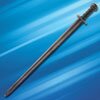 |
|
| Maldon Viking Sword Battlecry (501507) |
Points: 6

|
The Maldon Viking sword from Windlass Steelcrafts Battlecry collection is a light, agile and resilient fighting blade that captures nearly everything that made this style such a formidable and near legendary design. Created to deal with shields, mail and thick fur or leather armor, it was more than a match for any hand-weapon of its day. Its semi-rounded point was capable of forcefully biting into targets without snagging or catching while its well-honed edge, neither too wide nor too narrow, enabled the widest possible array of single-hand combination blows
|
|
|
|
|
|
 |
|
| Acre Crusader Broadsword Battlecry (501509) |
Points: 6

|
This medieval Acre Crusader Broadsword from Windlass Steelcrafts Battlecry collection is a formidable weapon of proven worth. This classic knightly sword was idea for sword and shield or sword and buckler combat whether on foot or horseback. The Acre crusader sword is a stout and fearsome blade that takes advantage of its heft, width, and center and gravity to deliver deadly slashing cuts and hacking blows as well as thrusts. One can easily imagine how this weapon shredded both mail and leather armors across Europe and Asia-minor for centuries.
|
|
|
|
|
|
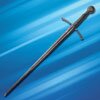 |
|
| Agincourt War Sword - Museum Replicas Battlecry (501506) |
Points: 6

|
Filling an under served niche in available swords today, the Agincourt hand-and-half sword from Windlass Steelcrafts Battlecry collection is a slender, light, quick weapon well-suited to facing armored or unarmored adversaries. This is an agile weapon whose length and weight make it highly effective on its own in either one or two-handed fighting. But it’s equally dangerous when paired with a buckler or even a larger shield. Combining versatility with utility, the dexterity and lightness of the Agincourt betrays a dangerous fighting blade of respected martial utility. With a 1065 high carbon steel blued patina, it’s well protected from the frequent rust spots and stains that occur so often from everyday practice and exposure to the elements. The battle-hardened finish had an extra wide tang and is tempering to a low 50's RC. This pre-sharpened blade has gone through rigorous testing.
|
|
|
|
|
|
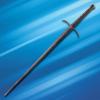 |
|
| Bosworth Longsword Battlecry (501505) |
Points: 6

|
This medieval Bosworth Longsword is from Windlass Steelcrafts Battlecry collection. Designed specifically to be used and made from 1065 high carbon steel with a darkened, battle-hardened finish, extra wide tang and tempering to a low 50's RC. This pre-sharpened blade has gone through rigorous testing.
The hands-on nature of the manufacturing by master smiths makes this line unique. Includes a matching scabbard with belt stop, custom packaging and certificate of authenticity signed by each smith that touched your blade through every step of the forging process.
|
|
|
|
|
|
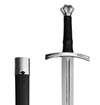 |
|
| Dynasty Forge Oakeshott XI (DF026) |
Points: 15

|
Single hand sword - Oakeshot XI type. High carbon 1050 steel, hand forged blade with fuller at whole length of blade, both sides. Handle made with wood, covered by black leather. Steel pommel and hilt. Includes black wood-leather scabbard with steel fittings.
|
|
|
|
|
|
 |
|
| Hanwei River Witham Sword (SH2372) |
Points: 11

|
The River Witham Sword was dredged from the River Witham near the town of Lincoln during work carried out in 1788. The sword may be a remnant of the Battle of Lincoln in 1141; however, it was most likely constructed between 1250-1300 CE. The inscription on the blade reads +NDXOXCHMDRCHDXORVI+. Iberia Swords are crafted in much the same way as swords were made centuries ago, except that the blades are now forged from high-carbon spring steel, a resource unavailable off-the-shelf to the smiths of the old. The blade finish is far from being polished, again more closely replicating what the medieval swordsmith was able to achieve. Except as noted, grips are leather-covered hardwood. Fittings are either steel or solid brass. Except, where shown all of these swords have scabbards of leather-covered wood with steel lockets and chapes and removable suspension rings. These swords will appeal to the re-enactor who wants a sword with the same appearance as the originals.
|
|
|
|
|
|
 |
|
| Hanwei Cawood Viking Sword (SH2457) |
Points: 24

|
The celebrated Cawood Sword, named after its discovery location near Cawood Castle in England, is regarded as one of the finest and best-preserved examples of an 11th century Viking sword in existence. Preserved in the mud of the bed of the River Ouse for almost a millenium, the sword has now found a permanent home in the Yorkshire Museum, where it is a leading attraction. What is almost certainly a “sister” sword was unearthed in Norway in 1888, giving a valuable clue to the Cawood Sword’s origin.
|
|
|
|
|
|
 |
|
| Hanwei Saxon Sword 9th century (SH2436) |
Points: 25

|
CAS Hanwei’s smiths have outdone themselves with their recreation of a 9th Century Saxon sword by replicating a technique used by the Saxons and Vikings and producing a stunning blade that features a pattern-welded core with high-carbon edge sections. This technique was used by the old-time smiths as a means of producing blades (just for the rich folks) that were sharp, resilient and decorative and, eleven hundred years on, CAS Hanwei has made them affordable.
The sword’s design is based on a 9th Century piece found in the bank of a stream in England in 1976 and now on display in the Yorkshire Museum.
|
|
|
|
|
|
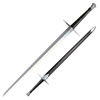 |
|
| Cold Steel Hand And A Half Sword (88HNH) |
Points: 24
|
Reflects the highest standards in workmanship and materials and comes fully sharpened and ready for battle. Suitable for both a one or two handed grip. Handle is wood covered in black leather.To balance the long 33.5" blade, we have capped the butt with a beautiful "scent stopper" pommel. Overall length is 42-5/8". Scabbard is leather with steel fittings.
|
|
|
|
|
|
 |
|
| Cold Steel Hand And A Half Dagger (88HNHD) |
Points: 13
|
Hand And a Half Dagger by Cold Steel. We would be hard pressed to think of a more versatile or effective sword than the "Bastard" or "Hand-and-a-Half Sword" we offer here. For a sword of this size, it's amazingly light and fast and tips the scales at approximately 3 lbs. Its 33 1/2" long blade is quite wide so it can produce deep shearing type cuts yet pointed enough to be effective in a thrusting attack. Its long handle is suitable for both a one or two handed grip and is fashioned out of wood covered in black leather. To balance the long blade we have capped the butt with a beautiful "scent stopper" pommel which can be a lethal weapon in its own right.
|
|
|
|
|
|
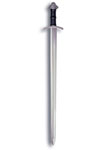 |
|
| Cold Steel Viking Sword (88VS) |
Points: 20

|
Features a double edge sharp blade, hand forged out of high carbon steel and then polished to a brilliant lustre. The wooden handle is covered in leather and is supported by a simple,elegant guard and an equally handsom 5 lobed pommel. Both guard and pommel feature tradiional Celtic knot decorative embellishments. Wood scabbard covered in black leather and reinforced with a highly polished steel chape and throat.
|
|
|
|
|
|
|
|
Tags:
martial arts, katana, iaito, sword, fencing, tonfa, boken, bokken, kama, shinai, samuraj, judo, karate, kenjutsu, kenjitsu, ninja, kungfu,
|















